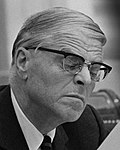Zijlstra cabinet
Zijlstra cabinet | |
|---|---|
Cabinet of the Netherlands | |
  The first meeting of the incoming Zijlstra cabinet on 21 November 1966 | |
| Date formed | 22 November 1966 |
| Date dissolved | 5 April 1967 134 days in office (Demissionary from 15 February 1967) |
| People and organisations | |
| Monarch | Queen Juliana |
| Prime Minister | Jelle Zijlstra |
| Deputy Prime Minister | Jan de Quay Barend Biesheuvel |
| No. of ministers | 13 |
| Member party | Catholic People's Party (KVP) Anti-Revolutionary Party (ARP) |
| Status in legislature | Centrist Minority government (Caretaker/Rump) |
| History | |
| Outgoing election | 1967 election |
| Legislature terms | 1963–1967 |
| Incoming formation | 1966 formation |
| Outgoing formation | 1967 formation |
| Predecessor | Cals cabinet |
| Successor | De Jong cabinet |
| Part of the Politics series |
![Azure, billetty Or a lion with a coronet Or armed and langued Gules holding in his dexter paw a sword Argent hilted Or and in the sinister paw seven arrows Argent pointed and bound together Or. [The seven arrows stand for the seven provinces of the Union of Utrecht.] The shield is crowned with the (Dutch) royal crown and supported by two lions Or armed and langued gules. They stand on a scroll Azure with the text (Or) "Je Maintiendrai" (French for "I will maintain".)](http://upload.wikimedia.org/wikipedia/commons/thumb/8/8f/State_coat_of_arms_of_the_Netherlands.svg/150px-State_coat_of_arms_of_the_Netherlands.svg.png) |
|---|
|
|
The Zijlstra cabinet was the executive branch of the Dutch Government from 22 November 1966 until 5 April 1967. The cabinet was formed by the christian-democratic Catholic People's Party (KVP) and the Anti-Revolutionary Party (ARP) after the fall of the previous Cabinet Cals. The caretaker rump cabinet was a centrist coalition and had a minority in the House of Representatives with former Protestant Leader Jelle Zijlstra a former Minister of Finance serving as Prime Minister and dual served as Minister of Finance. Former Catholic Prime Minister Jan de Quay served as Deputy Prime Minister and Minister of Transport and Water Management, Protestant Leader Barend Biesheuvel continued as Deputy Prime Minister, Minister of Agriculture and Fisheries and the responsibility for Suriname and Netherlands Antilles Affairs from previous cabinet.
The cabinet served in the middle of the tumultuous 1960s, domestically it had to deal with the counterculture and its primary objective was to make preparations for a snap election in 1967. Following the election the cabinet continued in a demissionary capacity until it was replaced by the De Jong cabinet.[1][2][3]
Formation
[edit]Following the fall of the Cals cabinet the Labour Party (PvdA) left the coalition and the Catholic People's Party and the Anti-Revolutionary Party formed a Rump cabinet.
Term
[edit]Such a transitional cabinet is not supposed to take important decisions, but it still resolved the issue over the introduction of commercial television, which had been a major issue in the two previous cabinets, with the omroepwet, which allowed commercial blocks on public television (between shows), despite protests by VVD and part of CHU.

Cabinet members
[edit]- Retained from the previous cabinet
- Continued in the next cabinet
References
[edit]- ^ "Kabinetscrisis 1966: de Nacht van Schmelzer" (in Dutch). Parlement & Politiek. 10 December 2010. Retrieved 3 June 2019.
- ^ "Misschien waren we allebei teveel boekhouder'" (in Dutch). NRC Handelsblad. 12 September 1991. Retrieved 1 April 2018.
- ^ "Kabinet Zijlstra – Vijftig jaar geleden aangetreden" (in Dutch). Andere Tijden. 22 November 2016. Retrieved 10 March 2018.
External links
[edit]- Official
- (in Dutch) Kabinet-Zijlstra Parlement & Politiek
- (in Dutch) Kabinet-Zijlstra Rijksoverheid





















